
This page is part of © FOTW Flags Of The World website
Flags of education and science institutions of the Dominican Republic
Last modified: 2019-01-12 by randy young
Keywords: dominican republic | academia superior de ciencias aeronáuticas | colegio serafin de asís | instituto superior de formación docente salomé ureña | instituto tecnológico de santo domingo | instituto tecnológico |
Links: FOTW homepage |
search |
disclaimer and copyright |
write us |
mirrors
See also:
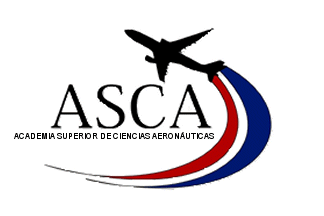
image by Randy Young, 6 August 2015
The Academia Superior de Ciencias Aeronáuticas (ASCA, Academy for Aeronautical Sciences) is the first institution in the Dominican Republic that specializes in the training of aviation personnel. The creation of ASCA was authorized in July 2009 by Resolution No. 12-2009 from the Ministry of Higher Education Science and Technology.
The flag of ASCA can be seen in the background of several photographs online, including at the school's website. The flag features the school logo centered on a white field. The logo shows the black silhouette of a commercial airliner flying toward the upper hoist, with a red, white, and blue trail stretching behind it toward the lower fly and back toward the lower hoist. Beneath the airliner are the school's initials in black serif letters, with the name of the school below in smaller, black, capital, sans serif letters.
Randy Young, 6 August 2015
![[Colegio Amador flag]](../images/d/do_colam.gif)
image by Ivan Sache, 9 January 2019
Colegio Amador, established in 1995 in Santo Domingo, was officially recognized on 11 February 1999 by the Secretariat of State of Education and Culture. The school was founded by Manuel Amador Santa Cruz and María de la Caridad López, two Professors of Mathematics at the University of Pinar del Río (Cuba), who emigrated to the Dominican Republic in 1992, and Fátima de Oriol, from Spain.1
The flag is white, representing loyalty and purity, with the school's emblem in the center.
- The emblem is surrounded by an elliptic border inscribed "CENTRO EDUCATIVO AMADOR."
- The emblem's main element, a white star, is a symbol of excellence and purity.
- The upper right part features the glorious Dominican flag. In the lower right part, the sun, a symbol of guidance, shines over three beautiful mountains (Duarte, Sánchez and Mella).
- The dominant blue color is a symbol of heavens, source of life and the realm of God, who protects us with all his love.2
Ivan Sache, 9 January 2019
Sources:
1 - School website (http://amador.edu.do/)
2 - School website (http://amador.edu.do/historia/logo-y-bandera-del-colegio/)
![[Colegio Dominicano de la Salle flag]](../images/d/do_cdls.gif)
image by Randy Young, 27 March 2016
The Colegio Dominicano de la Salle is an institution of higher education headquartered in Santo Domingo. The school follows a religious curriculum, focusing on "values specified in the Gospel," according to the college's website.
The flag of Colegio Dominicano de la Salle can be seen in photographs online at http://hoy.com.do/wp-content/uploads/2012/02/39285CAC-0701-4F2E-B976-C5D2B0622A63.jpeg, http://elnacional.com.do/wp-content/uploads/2015/02/6_Actualidad_13_3okkp01.jpg, and http://hoy.com.do/wp-content/uploads/2009/02/E7A4DF57-0D08-4906-8CEA-9280022CBF98.jpeg. The flag features a white St. George's cross on a blue field. At the center of the cross is the college's coat of arms, with the words "COLEGIO" and "DE LA SALLE" on either side of the coat of arms, on the white horizontal arms of the cross, in red capital letters.
Randy Young, 27 March 2016
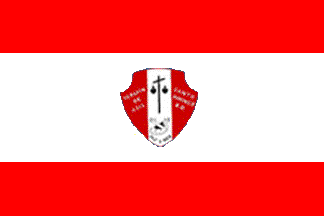
image by Ivan Sache, 7 November 2010
Colegio Serafín de Asís was set up on 2 February 1931 in Santo Domingo by the Franciscan Sisters of the Sacred Heart, a congregation founded in 1884 by the Spanish nun Blessed Mother María del Carmen González Ramos.
The first white and red flag used by Colegio Serafín de Asís was offerred by alumnus María Natalia de la Rocha. A photo shown on the institute's website shows the curent flag as horizontally divided red-white-red, seemingly 1:2:1, with the institute's coat of arms in the middle.
The coat of arms of Colegio Serafín de Asís is vertically divided red-white-red. The red stripes, meaning love and martyr, are charged with the white writing "Serafín / de / Asís" (left), "Santo / Domingo / R.D." (left). In the lower part of the central stripe are shown the arms of Christ and St. Francis of Assisi crossed per saltire; Christ's arm is naked, while Francis' arm is clad and has the stigmata on the hand. In the upper part of the central stripe is shown a Christian cross surrounded by two hearts each surmounted by a Christian cross, here the sacred hearts of Jesus and Mary. The congregation's motto "Paz y Bien" (Peace and Good) is placed below the crossed arms.
Ivan Sache, 7 November 2010
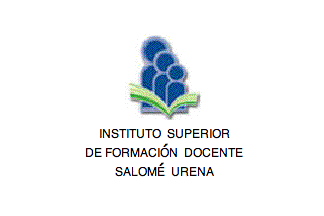
image by Ivan Sache, 27 December 2014
Instituto Superior de Formación Docente Salomé Ureña (ISFODOSU) was established in 2002 as the merger of Instituto de Formación y Capacitación Magisterial (INAFOCAM), Escuela Nacional de Educación Física (ENEF; Santo Domingo, 1942), and the five Normal Schools (renamed in 2000 Institutos Universitarios de Formación Docente): Félix Evaristo Mejía (Santo Domingo, 1953), Juan Vicente Moscoso (San Pedro de Macorís, 1956), Luis Napoleón Núñez Molina (Licey al Medio, 1950), Emilio Prud’Homme (Santiago de los Caballeros, 1952), and Urania Montás (San Juan de la Maguana, 1976).
The institute was named in 2003 for Salomé Ureña de Henríquez, who established in 1881 the Instituto de Señoritas, renamed for her in 1897.
The flag of ISFODOSU is white with the emblem of the institute in the middle.
Ivan Sache, 27 December 2014
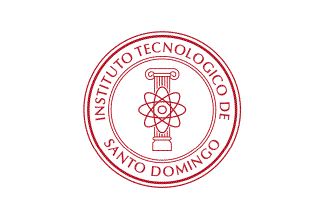
image by Ivan Sache, 12 December 2014
Instituto Tecnológico de Santo Domingo (INTEC) was inaugurated on 9 October 1972, offering three postgraduate programs in industrial engineering, economics, and business administration. Bachelor programs in civil engineering, industrial engineering, medicine, economics, administration, accounting, and social sciences were started in July 1973. INTEC decided in 2006 to limit the number of students to 5,000.
The flag of INTEC is white with the emblem of the university in the middle. Photos of the flag can be seen here, here, and here.
The emblem of INTEC is described in Chapter 1b of the Corporate Manual as follows:
The emblem (or coat of arms) is made of two concentric circles framing the writing "INSTITUTO TECNOLOGICO DE SANTO DOMINGO". In the middle stands a Ionic column superimposed in the middle with an atom. The font is Optima and the [red] colour is Pantone 185 C. The emblem is constructed on a grid whose basic unit is the imaginary square framing letter "D" of "DOMINGO".
The colour specifications are given in Chapter 2, for red:
Pantone 185 C / CMYK (%) 100-100-0-5 / RGB 231-0-51 / Web Safe e70033
Ivan Sache, 12 December 2014
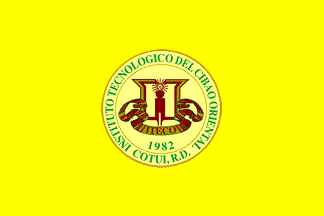
image by Ivan Sache, 27 February 2006
A higher-education institute flag: Flag and logo of Instituto Tecnológico del Cibao Oriental in the Dominican Republic are presented here.
Valentin Poposki, 18 February 2006
The state university Instituto Tecnológico del Cibao Oriental (ITECO) was founded on 10 February 1982 by the Organism for the Development of the Province of Sánchez Ramírez, a state body created by Decree 1206 on 27 September 1979 with the aim of using 5% of the benefits of the mining company Rosario Dominicana located in Pueblo Viejo, Cotuí. ITECO was founded by engineer Ramón Flores García and other citizens interested in the development of the region. The Institute was inaugurated on 11 October 1982, with 258 students. Decree 820 signed by the Executive on 25 February 1983 allowed to Institute to give titles and diplomas.
The flag of ITECO is yellow with the emblem of the Institute in the middle. The colours of the emblem represent the policy and the priorities of the Institute. Brown represents interest in the land and the natural resources; yellow represents the mines, which are at the origin of the foundation of ITECO; green represents the environment. In the middle of the emblem is a symbolic representation of Man.
Ivan Sache, 27 February 2006
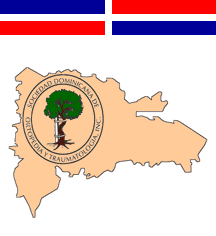
image by António Martins, 18 February 2006
Interesting table flag of Sociedad Dominicana de Ortopedia y Traumatología in Dominican Republic. Right here.
Valentin Poposki, 18 February 2006
Flag photo on line; it is a table flaglet hanging from a crossbar. Shows the organization's logo on a map outline on a white background; on the hoist (the top of the flag), a stripe filled with the national flag pattern (no arms).
António Martins, 18 February 2006
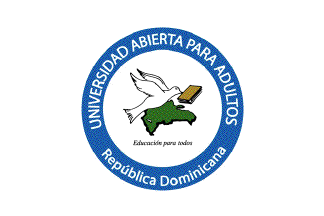
image by Ivan Sache, 18 December 2014
Universidad Abierta para Adultos (UAPA - Open University for Adults) is a private university headquartered in Santiago. UAPA is specialized in distance learning.
The flag of UAPA is white with the seal of the university in the middle.
The seal of UAPA features on a white background a white dove holding a brown book in its beak and flying over a green map of the Dominican Republic. Beneath is written the motto of the university "Educación por todos" (Education for All). The seal is bordered by a blue ring inscribed with the name of the university and of the country.
Ivan Sache, 18 December 2014
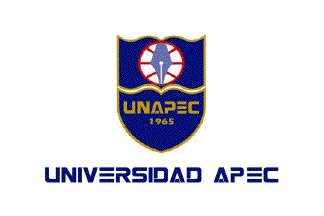
image by Ivan Sache, 15 December 2014
Universidad APEC (UNAPEC), headquartered in Santo Domingo, with a secondary seat in Santiago, is formed of the Faculties of Art and Communication, Economical and Business Sciences, Law, General Studies, Engineering and Computer Sciences, and Tourism.
Universidad APEC (UNAPEC) is the continuation of Instituto de Estudios Superiores (IES), which was established in 1964 by the Acción Pro Educación y Cultura Inc. (Action for Education and Culture, APEC) organization. The first faculty was established in September 1965, made of the Schools of Business Administration, Accounting, and Executive Spanish and Bilingual Secretariat. The institute was recognized as a university by Decree No. 2,985, adopted in 1968. The institute was renamed UNAPEC by Resolution No. 3, adopted on 11 August 1983 by the Board of APEC. The new name was recognized by Decree No. 2,710 of 29 January 1985.
The flag of UNAPEC is white with the logo and name of the university written below. Photos of the flag can be seen here, here, and here.
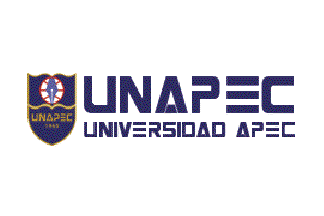
image by Ivan Sache, 15 December 2014
The flag is also used with the acronym and name of the university written on two lines at the logo's right.
The logo of UNAPEC is described in Article 2 of the General Statutes of the university, adopted on 4 October 2005 and approved by Decree No. 43 of 29 May 2006.
Article 2.
The logo of Universidad APEC shall be the heraldic emblem of all the institutions affiliated to Acción Pro Educación y Cultura Inc. (APEC). It features an open book, charged in the middle with a globe, represented by a red circle, with the Equator and two parallels superimposed with the head of a blue pen nib. Beneath the book appears the acronym "UNAPEC."
Ivan Sache, 15 December 2014
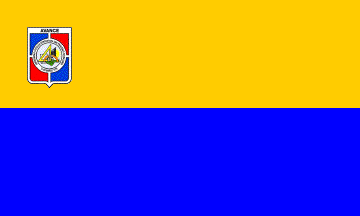
image by Ivan Sache, 13 December 2014
Universidad Católica Nordestana (UCNE) is located in San Francisco de Macorís. The university is directed by the Bishop of San Francisco de Macorís and managed by Fundación Universitaria Católica Nordestana, Inc. UCNE is organized in the Faculties of Health Sciences, Economical and Social Sciences, Engineering, and Legal Sciences. Universidad Nordestana (UNNE), established on 14 March 1978, was officially recognized by Decree No. 3,487 of 14 July 1978. Universidad Católica Nordestana (UCNE) was recognized a Catholic university by Episcopal Decree No. 87 of 18 August 2001.
The flag of UCNE is horizontally divided yellow-blue with the coat of arms of UCNE in the upper left corner. Photos of the flag can be seen here and here.
The coat of arms of UCNE is described in Article 3 of the university's Statutes, adopted on 4 May 2007 by Fundación Universitaria Católica Nordestana, Inc., as follows:
Article 3. Description of the coat of arms.
a) Description.
The heraldic description of the coat of arms is a right-angled triangle (yellow), a half cogwheel (brown), a white parchment behind the longer side of the triangle and the cogwheel. A caduceus inserted in the middle of the vertical side of the triangle, with white snakes, staff and wings that enter the cogwheel. Five columns (black) in perspective from right to left, the tallest starting in the middle of the right part of the half cogwheel and the last close to the upper part of the vertical side of the triangle. A golden, semicircular sun, whose outer curve is located between the first column and the right part of the half cogwheel. Two balloons united by a test tube placed behind the lower part of the vertical side of the triangle, the one at the right standing on the northeastern part of the map and the other at the left standing on the beginning of the horizontal side of the triangle. The whole supported by a map of the northeastern region, in green. A blue circle surrounds the described elements. A white circle charged with the writing quartered by a cross "Universidad Católica Nordestana". Blue and vermillion red quarters.
b) Composition.
The yellow triangle is superimposed with the cogwheel, on which stand the five black columns and the circles of the same colour, and the semicircular sun. In the center of the vertical side of the triangle is placed the caduceus; behind it, a balloon on the left and another on the right, over the map of Northeast. The white parchment is placed behind the left parts of the triangle, of the map and of the half-cogwheel. The four quarters of the flag are arranged as on the national coat of arms.
c) Symbolism.
The right-angled triangle represents mathematical sciences. The parchment represents the social and juridical sciences, art and culture. The half-cogwheel represents the technology required to impulse the economical development of the region. The caduceus represents health sciences, emphasizing the deep involvement of the university in the protection of life. The five columns symbolize the industrial power of the five northeastern provinces due to the university. The sun represents clarity and humanism. The balloon represents scientific accuracy in research and experimentation, theory and practice.
Ivan Sache, 13 December 2014
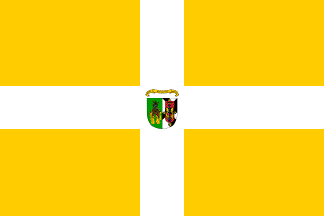
image by Ivan Sache, 28 December 2014
Universidad Católica Santo Domingo (UCSD) is a private university headquartered in Santo Domingo. UCSD is formed of the Faculties of Economical and Administrative Sciences, Health Sciences, Juridical and Political Sciences, Religious Sciences, Science and Technology, Social and Communication Sciences, Humanities and Education, and Architecture and Art.
UCSD, approved on 5 July 1983 by the Episcopal Conference of the Dominican Republic, was inaugurated on 29 August 1983 and officially recognized by Decree No. 2,048 of 8 June 1984. The founders of UCSD are Octavio Antonio Cardinal Beras Rojas (1960-1990; Archbishop of Santo Domingo, 1961-1981; Military Archbishop of the Dominican Republic, 1962-1982; elevated to Cardinal-Priest of San Sisto on 24 May 1976), Dr. Cesar Iván Féris, Dr. Andrés Dauhajre and Friar Vicente Rubio, who established the Fundación Universitaria Católica.
The flag of UCSD is golden yellow with a white cross (that is, the design of the flag of the Dominican Republic with the colours of the Holy See) charged in the middle with the coat of arms of the university. The flag can be seen in photographs here, here, here, and here.
The coat of arms of UCSD is "Per pale, 1. A Chair of St. Peter proper, 2. Santo Domingo". The shield is surmounted by a scroll or inscribed with the Biblical motto "Deus Scientiarum Dominus" (God [is] the Master of Science / Lord is a God who knows; 1 Samuel 2:3) in letters Sable. The Chair / Throne of St. Peter, executed from 1647 to 1653 by Gian Lorenzo Bernini (1598-1680), is conserved in St. Peter's Basilica in Rome. It is supported by four Western doctors of the Church: St. Hieronymus, St. Ambrose, St. Augustine, and Pope St. Gregory the Great*. The arms of Santo Domingo are "Gules a key Azure two lions affronty Or in chief a crown open of the same a bordure charged with the Cross of the Order of St. Dominic."
*The description is erroneous. The Chair of St. Peter is indeed supported by two Western doctors, St. Ambrose and St. Augustine, and two Eastern doctors, St. John Chrysostom and St. Athanasius.
Ivan Sache, 28 December 2014
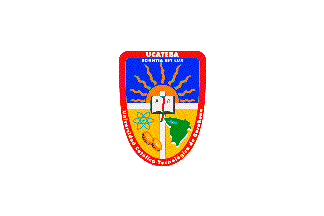
image by Ivan Sache, 17 January 2015
Universidad Católica Tecnológica de Barahona (UCATEBA) is a private university located in Juan Pablo Duarte Sector, Villa Central Municipal District, Municipality of Barahona. Owned by the Barahona Diocese, UCATEBA is managed by Fundación Universitaria Católica Tecnológica de Barahona, Inc. The university is made of the Schools of Law, Nursing, Education, Computer Science, and Commerce. UCATEBA was established by Decree No. 770 of 9 August 2004. Its founders are Rafael Leónidas Felipe y Núñez (b. 1938), 2nd Bishop of Barahona (1999-), and Fabio Mamerto Rivas Santos (b. 1932), 1st Bishop and Bishop Emeritus of Barahona (1976-1999).
The flag of UCATBA is white with the university's emblem in the middle, as seen in photos here, here, here, and here.
The emblem of UCATEBA is a shield featuring the following elements:
a red border charged in the lower part with the university's name in black letters [white on the drawings] and in the upper part with the UCATEBA acronym in white letters;
the first, upper quarter, blue with an orange rising sun surmounted by the motto "SCIENTIA EST LUX" [Science is Light] [in white letters];
the second, lower left quarter, light yellow with an [blue] atom and a [orange] cogwheel, representing science and work, respectively;
the third, lower right quarter, light yellow with a green map of Entiquillo Region, green being a symbol of hope;
the shield quartered by a white cross charged in the middle with an open Bible inscribed with the Greek letters Α and Ω and equipped with a purple red bookmark.
Ivan Sache, 17 January 2015
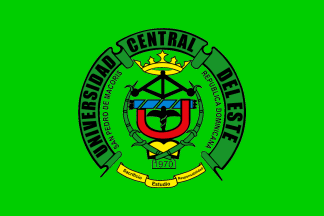
image by Randy Young, 23 January 2016
Universidad Central del Este (UCE, Eastern Central University) is a private university founded in 1970 in the city of San Pedro de Macorís in southeastern Dominican Republic. UCE operates a medical center in Santo Domingo, and has 12 undergraduate academic departments.
The university flag can been seen in photographs online, particularly here and here. The flag consists of the university seal centered on a light green field.
Randy Young, 23 January 2016
Sources: Wikipedia article and UCE website
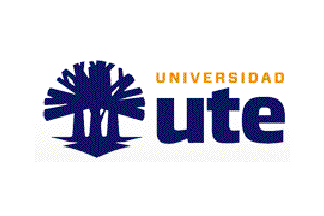
image by Ivan Sache, 27 December 2014
Universidad de la Tercera Edad (UTE) was established in 1988 in Santo Domingo by Nicolás Almánzar. Tercera Edad, lit. "Third Age," refers to people older than 65, usually retired from professional life, who would be called "Senior Citizens" in the United States. UTE was incorporated by Decree No. 544 of 25 November 1988 and officially recognized as an academic institution by Decree No. 56 of 26 February 1992.
The flag of UTE is white with the emblem of the university in the middle.
Ivan Sache, 27 December 2014
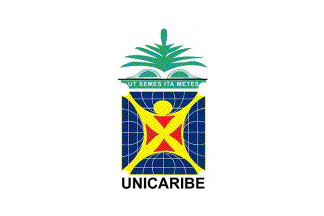
image by Ivan Sache, 27 December 2014
Universidad del Caribe (UNICARIBE), established in 1995 by Fundación Educativa del Caribe, was recognized by Decree No. 234 of 12 October 1995. The founder and first Rector of UNICARIBE is Dr. José Andrés Aybar Sánchez. UNICARIBE is formed of the three Schools of Humanities, Commerce, and Legal Sciences.
The flag of UNICARIBE is white with the coat of arms of the university in the middle, and can be seen in photographs here, here, here, here, and here.
The coat of arms of UNICARIBE is made of a rectangular vertical shield, on the model of those designed in the Middle Ages. In the middle is represented a human figure, in yellow, covering the globe with his hands and legs, as a symbol of the domination on the world obtained by knowledge. In the center is the red cross used by the Crusaders and by the Church for the evangelization of the world, meaning that UNICARIBE pushes a peaceful world. The shield is surmounted by a perennial plant, symbolizing that knowledge lasts all along the life. The Latin motto "UTA SEMES ITA METES" means "You Shall Harvest What You Sow."
Ivan Sache, 27 December 2014
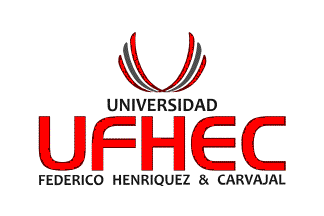
image by Ivan Sache, 18 December 2014
Universidad Federico Henríquez y Carvajal (UFHEC) has four campuses, located in Santo Domingo, Baní, La Romana and Moca. The university is named for the doctor, lawyer, writer and politician Federico Henríquez y Carvajal t1859-1935), President of the Republic from 31 July to 29 November 1916, when he was ousted by the American invasion of the country.
The flag of UFHEC is white with the emblem (in a red shade much brighter than on the self-standing emblem) of the university. Photos of the flag can be seen here and here.
Ivan Sache, 18 December 2014
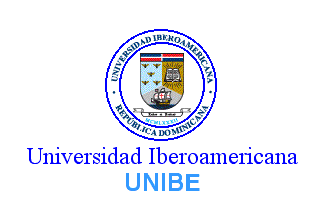
image by Ivan Sache, 17 December 2014
Universidad Iberoamericana (UNIBE) is a private university headquartered in Santo Domingo and with a campus in La Altagracia (Eastern Region). UNIBE is formed of the Faculties of Health Sciences, Social Sciences, Engineering, Law, Education, and Art.
UNIBE was initiated on 12 January 1982 by Instituto de Cooperación Iberoamericana (ICE), the Spanish agency for international cooperation (today, AECID) and a local Steering Committee. UNIBE was officially recognized by Decree No. 3,371 of 12 July 1982. Classes Law, Engineering, and Medicine started on 1 September 1983. The founder and first Rector of UNIBE is Dr. Jorge Abraham Hazoury Bahlés.
The flag of UNIBE is white with the university's emblem. Beneath the emblem is written the full name of the university in blue letters, and, beneath, the acronym "UNIBE" in lighter blue letters. It can be seen in photographs here, here, here, here, and here.
Ivan Sache, 17 December 2014
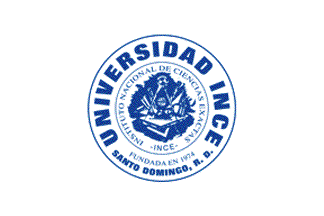
image by Ivan Sache, 12 December 2014
Universidad INCE, founded as Instituto Nacional de Ciencias Exactas (National Institute of Exact Sciences, INCE), by Decree No. 5,418 of 18 March 1974, was established by Decree No. 4,515 of 10 December 1974.
The flag of Universidad INCE is white with the seal of the university in the middle.
Ivan Sache, 12 December 2014
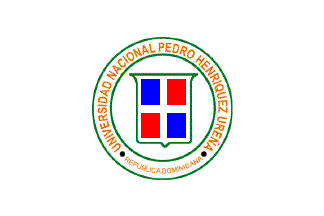
image by Ivan Sache, 12 December 2014
Universidad Nacional Pedro Henríquez Ureña (UNPHU), established on 27 March 1967, is the oldest private university in the Dominican Republic. UNPHU is managed by the Fundación Universitaria Dominicana Pedro Henríquez Ureña Inc. (FUDPHU), which was established on 10 May 1966 and incorporated by Decree No. 1,247 of 17 May 1966. UNPHU is headquartered in Santo Domingo, with a campus in La Vega (established on 5 March 1973) and a branch in New York.
UNPHU is organized in the Faculties of Health Sciences, Economical and Social Sciences, Juridical and Political Sciences, Science and Technology, Education and Humanities, Architecture and Art, and Agronomic Sciences and Natural Resources. UNPHU is named for the Dominican philologist and writer Pedro Henríquez Ureña (1884-1946), who spent most of his professor and writer's career in Argentina.
The flag of UNPHU is white with the seal of the university in the middle. Photos of the flag can be seen here, here, here, here, here, here, here, here, and here.
The seal of UNPHU features a shield quartered blue and red by a white cross (similar to the national flag, coat of arms excluded) with a white border and a green outline. The shield is placed on a white disk bordered by a white ring outlined in green and inscribed with the name of the university and of the country in orange yellow letters.
Colegio Pre-Universitario Dr. Luis Alfredo Duvergé Mejia is part of UNPHU. Its flag is white with the emblem of the college in the middle. The emblem of the college is a circular version of the national flag, coat of arms excluded, surrounded by a white ring outlined in black and inscribed with the name of the university (and of the country?) in black letters.
Ivan Sache, 12 December 2014
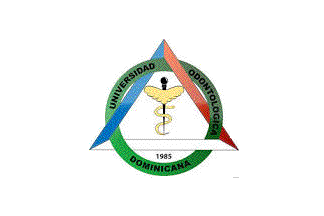
image by Ivan Sache, 18 December 2014
Universidad Odontológica Dominicana (UOD) was established in 1985 in Santo Domingo.
The flag of UOD is white with the emblem of the university in the middle. Photos of the flag can be seen here, here, and here.
Ivan Sache, 18 December 2014
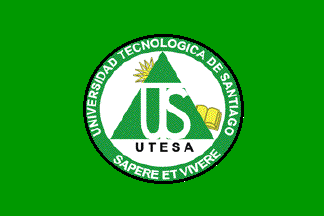
image by Ivan Suche, 15 December 2014
Universidad Tecnológica de Santiago (UTESA) is headquartered in Santiago, with campuses in Santo Domingo, Puerto Plata, Mao and Moca. With more than 5,000 students, UTESA claims to be the biggest private university in the country. UTESA is formed of the Faculties of Economical and Social Sciences, Health Sciences, Secretariat Sciences, and Sciences and Humanities.
UTESA was inaugurated on 12 November 1974 and officially recognized by Decree No. 1,944 of 19 April 1976.
The flag of UTESA is green with the seal of the university in the middle, bordered in black. The flag can be seen in photos here and here.
The flags used in sports events, probably less "official", are slightly different, either with a broader black border around the seal or the green border of the seal in a darker shade of green than the background of the flag. Photos of the athletics flag can be seen here and here.
The seal of UTESA features on a white background a green triangle charged with the white letters "U, "T", and "S", and superimposed in the upper left part to a yellow sun and in the lower right part to a yellow open book. The green border of the seal is inscribed with the name of the university and its motto, "SAPERE ET VIVERE" (To Know and To Live) in white letters. "UTESA" is written in black letters beneath the triangle.
A Colegio Utesiano de Estudios Integrados (CUEI, UTESA School of Integrated Studies) was established in 1993 on each campus of UTESA. The flag of CUEI-UTESA is white with the college's seal in the middle. The seal features on a white background a map of the earth with the continents represented in gray, superimposed with a yellow parabolic antenna.
Ivan Sache, 15 December 2014
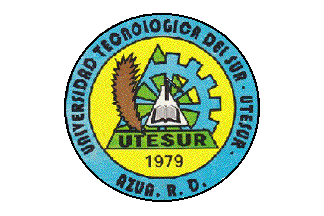
image by Ivan Sache, 17 December 2014
Universidad Tecnológica del Sur (UTESUR) is headquartered in Azua. UTESUR is organized in the Schools of Computer Sciences, Bioanalysis, Business Administration, Accounting, Marketing, Law, Nursing, Education, and Agronomy.
UTESUR was founded by the sociologist and pastor Anthony Campolo (b. 1935), founder of the Evangelical Association for the Promotion of Education (EAPE), mostly known as the former spiritual advisor of US President Bill Clinton.
The flag of UTESUR is white with the emblem of the university in the middle.
Ivan Sache, 17 Decemer 2014


![[Colegio Amador flag]](../images/d/do_colam.gif)
![[Colegio Dominicano de la Salle flag]](../images/d/do_cdls.gif)




















